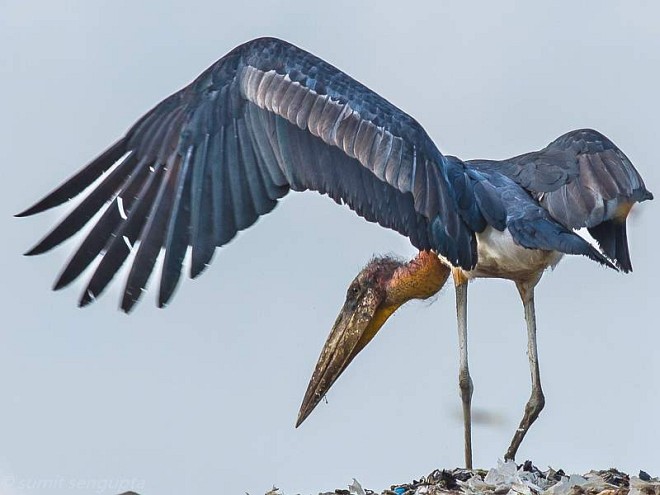Greater adjutant
(Leptoptilos dubius)

Description
The greater adjutant (Leptoptilos dubius) is a member of the stork family,Ciconiidae.Its genus includes the lesser adjutant of Asia and the marabou stork of Africa.Once found widely across southern Asia,mainly in India but extending east to Borneo,the greater adjutant is now restricted to a much smaller range with only two breeding populations;one in India,with the largest colony in Assam and the other breeding region in Cambodia.They disperse after the breeding season.This large stork has a massive wedge-shaped bill,a bare head and a distinctive neck pouch.During the day,they soar in thermals along with vultures with whom they share the habit of scavenging.They feed mainly on carrion and offal;however,they are opportunistic and will sometimes prey on vertebrates.The English name is derived from their stiff "military" gait when walking on the ground.Large numbers once lived in Asia,but have declined greatly,possibly due to improved sanitation,to the point of being endangered.The total population in 2008 was estimated at around a thousand individuals.In the 19th century,they were especially common in the city of Calcutta,where they were referred to as the "Calcutta adjutant".Known locally as hargila (derived from the Bengali words for "bone-swallower") and considered to be unclean birds,they were largely left undisturbed but sometimes hunted for the use of their meat in folk medicine.Valued as scavengers,they were once used in the logo of the Calcutta Municipal Corporation.The greater adjutant is a huge bird,standing tall at 145–150 cm (57–59 in).The average length is 136 cm (54 in) and average wingspan is 250 cm (98.5 in).While no weights have been published for wild birds,the greater adjutant is among the largest of living storks,with published measurements overlapping with those of the jabiru (Jabiru mycteria),saddle-billed stork (Ephippiorhynchus senegalensis) and marabou stork (Leptoptilos crumeniferus).Juvenile greater adjutant storks in captivity weighed from 8 to 11 kg (18 to 24 lb).For comparison,the heaviest known wild stork was a marabou stork scaling 8.9 kg (20 lb).The huge bill,which averages 32.2 cm (12.7 in) long,is wedge-like and is pale grey with a darker base.The wing chord averages 80.5 cm (31.7 in),the tail 31.8 cm (12.5 in) and the tarsus 32.4 cm (12.8 in) in length.With the exception of the tarsus length,the standard measurements of the greater adjutant are on average greater than that of other stork species.A white collar ruff at the base of its bare yellow to red-skinned neck gives it a vulture-like appearance.In the breeding season,the pouch and neck become bright orange and the upper thighs of the grey legs turn reddish.Adults have a dark wing that contrasts with light grey secondary coverts.The underside of the body is whitish and the sexes are indistinguishable in the field.Juveniles are a duller version of the adult.The pendant inflatable pouch connects to the air passages and is not connected to the digestive tract.The exact function is unknown,but it is not involved in food storage as was sometimes believed.This was established in 1825 by Dr John Adam,a student of Professor Robert Jameson,who dissected a specimen and found the two layered pouch filled mainly with air.The only possible confusable species in the region is the smaller lesser adjutant (Leptoptilos javanicus),which lacks a pouch,prefers wetland habitats,has a lighter grey skull cap,a straighter edge to the upper mandible and lacks the contrast between the grey secondary coverts and the dark wings.Like others storks,it lacks vocal muscles and produces sound mainly by bill-clattering,although low grunting,mooing or roaring sounds are made especially when nesting.The bill-clattering display is made with the bill raised high and differs from that of the closely related African marabou which holds the bill pointed downwards.
Taxonomic tree:







